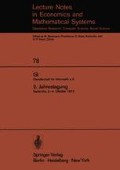Summary
Given a multiprocessor system consisting of M identical processors. Given N tasks and precedence rules for the execution of these tasks, represented as a finite, weighted forest G (whose paths are directed from leaves to roots). Given finally an upper bound T > 0 for the total processing time of G by the M processors. We assume that preemptions are allowed.
In an elementary way for this model 1) precise lower bounds Tmin(G;M) and Mmin(G;T) are developed: 2) and for T ≥ Tmin(G;M) or M ≥ Mmin(G;T) the ‘admissible’ processor assignments and their maximal running times are derived, and 3) the structure and therefore the set of all schedules is described that lead to complete processing of all tasks of G by M processors within time T.
Access this chapter
Tax calculation will be finalised at checkout
Purchases are for personal use only
Preview
Unable to display preview. Download preview PDF.
References
HU, T.C.: Parallel Sequencing and Assembly line Problems, Operations Research 9, No.6 (1961), 841–848.
COFFMAN, E.G. and GRAHAM, R.L.: Optimal Scheduling for Two-Processor Systems, Acta Informatica 2 (1972).
SCHINDLER, S.: On Optimal Schedules for Multiprocessor Systems, Princeton Conference on Information Sciences and Systems, March 23–24, 1972.
SCHINDLER, S.: Optimal Schedules for Several Different Processors on Computational Graphs, to be published.
BARSKIY, A.B.: Minimizing the Number of Computing Devices Needed to Realize a Computational Process within a Specified Time, Engineering Cybernetics, No.6, 1968.
SCHINDLER, S.: Scheduling a Multiprocessor System on Anti-Forests, SIAM-SIGNUM 1972 Fall Meeting, Austin, Oct. 16–18.
SCHINDLER, S.: Quantitative Aspects of Optimal Schedules for Multiprocessor Systems, Workshop on Parallel Computation, Seattle, June 21–23, (1972).
LIU, C.L.: Optimal Scheduling on Multiprocessor Computing Systems, Conference on Switching and Automata Theory, Maryland, Oct. 25–27, (1972).
FERNANDEZ, E.B. and BUSSEL, B.: Bounds on the Number of Processors in Parallel Computation, Workshop on Parallel Computation, Seattle, June 21–23, (1972).
Editor information
Editors and Affiliations
Rights and permissions
Copyright information
© 1973 Springer-Verlag Berlin · Heidelberg
About this paper
Cite this paper
Schindler, S. (1973). Classes of Optimal Schedules for Multiprocessor Systems. In: Deussen, P. (eds) GI. Gesellschaft für Informatik e.V. 2. Jahrestagung. Lecture Notes in Economics and Mathematical Systems, vol 78. Springer, Berlin, Heidelberg. https://doi.org/10.1007/978-3-642-80732-9_25
Download citation
DOI: https://doi.org/10.1007/978-3-642-80732-9_25
Publisher Name: Springer, Berlin, Heidelberg
Print ISBN: 978-3-540-06127-4
Online ISBN: 978-3-642-80732-9
eBook Packages: Springer Book Archive

